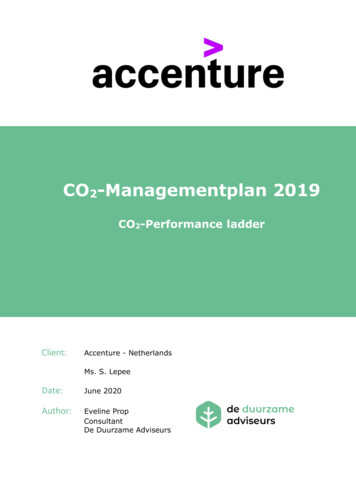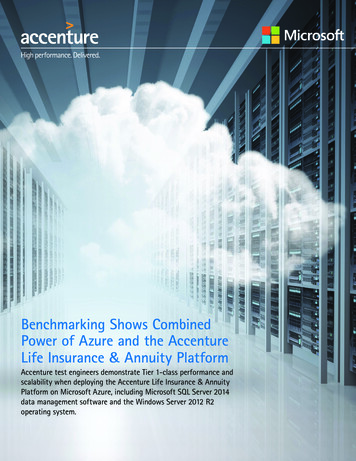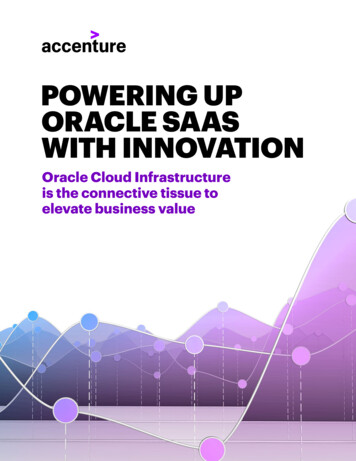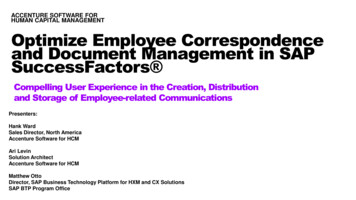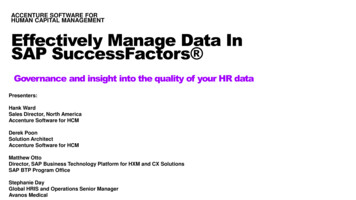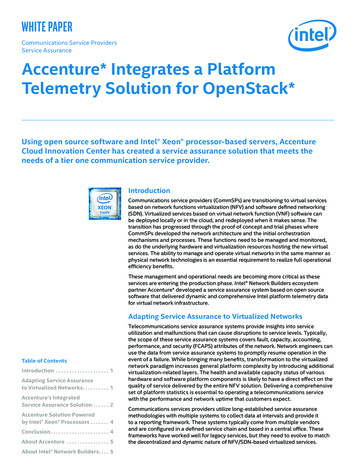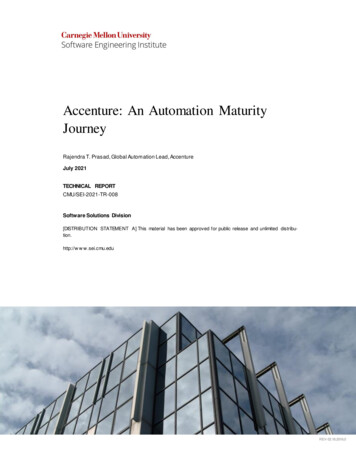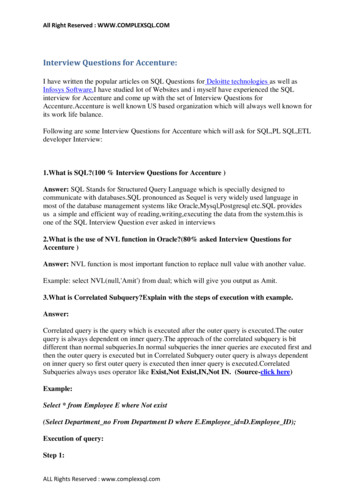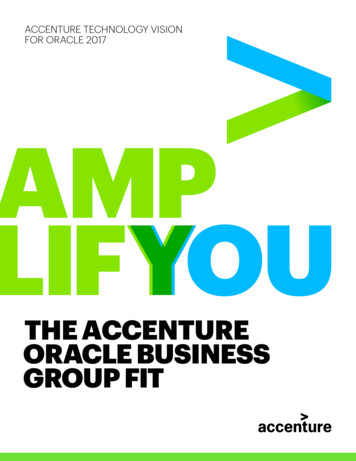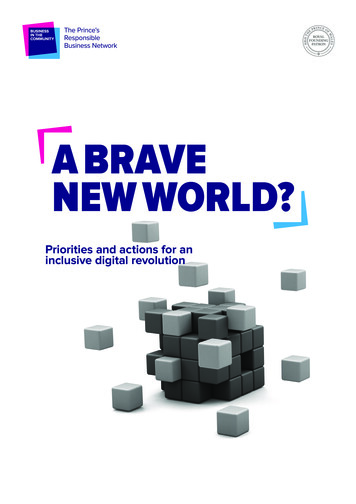
Transcription
Schrems II @AccentureMarch 2022
Schrems II @ AccentureAt Accenture, meeting the highest ethical standards is paramount.We maintain a global data privacy program closely aligned to GDPR standards and treat privacy as a fundamental right for allindividuals, and therefore take the protection of the personal data we handle for us and on behalf of our clients very seriously.While we already have a strong program in place to address data privacy, the European Court of Justice (ECJ) July 2020 decision, knownas “Schrems II,” requires organizations to take further actions around protection. Specifically, organizations are to assess and identify if,when moving personal data to most countries outside of the European Economic Area (EEA), there is a risk the information can beaccessed and ultimately exposed to foreign authorities. Should an increased risk of exposure exist, specific “supplementary measures”to mitigate the risk need to be applied.In response, Accenture has assessed our current compliance approach and standards, consulting with our external legal counsel toconfirm our process addresses the Schrems II requirements. We have also strengthened our business-as-usual process, assessedrelevant country laws and performed Transfer Impact Assessments where Accenture is an exporter. Our ISO 27001 and ISO27701certified Data Privacy and Information Security programs have been reviewed to ensure they address the European Data ProtectionBoard (EDPB) recommendations on supplementary measures.Based on our review of the relevant laws, as well as the standard supplementary measures and controlled clauses we’ve embedded intoour process, we believe we are well positioned to continue to deliver our services in a manner consistent with how we do today.Understandably, there still may be questions and concerns not addressed within this overview. We remain readily available tocommunicate and work closely with you, our client, to ensure everyone is aligned in driving privacy compliance.
Certified secureReady for Schrems IIAccenture maintain a global data privacy programclosely aligned to GDPR to enable a consistent, globalstandard to address client and business data protection.Security is in our DNA.NIST Cyber Security Framework (CSF)Assessed as “at” or “exceeding” in all categoriesagainst its peer and industry verticals by BSIISO 27001* and 27701*This has enabled us to achieve and maintain ISO 27001and 27701 certifications of our enterprise data privacyand client data protection programs.Maintains certification for information security anddata privacy standardsAccenture’s ISO-certified Enterprise and Client DataProtection programs embody our steadfast dedicationto information security and are reinforced by ourstandings with other industry standards organizations.CIS Critical Security Controls Version 7.1Finally, all Accenture people are required to participatein award-winning programs focused on instilling smartsecurity and data protection practices.CSA Security, Trust & AssuranceRegistry (STAR)*The ISO/IEC 27000 family of standards helps organizations keep information assets n-security.htmlMaintains at or above its peers and industry verticalsin all 20 categories, validated by Verizon SecurityServicesAwarded, and maintains, the highest Gold-levelcertification for Accenture-managed cloudinfrastructure and certification of CIO cloud services(to be extended across all cloud services)
Accenture IS and DP management systemsRepresenting a standardized, information-centric framework implemented across theentire Accenture environment covering information security (IS) and data privacy (DP). InformationSecurity and Privacy Information Management Systems share complementary security and data privacycontrols. The Client Data Protection (CDP) program supports the IS and DP ISO certification programs.Information Security (ISMS)& Data Privacy (PIMS)FrameworkImplementedthroughImplemented byEvidenced byInformation Security & kets/Market Units &SubsidiariesServicesClient DataProtectionInternalAuditInformation rnal AssessmentsClient Account CDP Plans(ISO 27001, ISO 27701,CSA STAR, SANS, NIST,Independent outside counselreview)Validated byInformation SecurityManagement System(ISO/IEC 27001:2013)ISO 27001EnterprisecertificateISO 27001CDPcertificatePrivacy InformationManagement System(ISO/IEC 27701:2019)
Client data protectionOur Client Data Protection [CDP] program providesproject teams with a standardized approach to managingrisk through a set of processes, controls, and metrics.This ISO 27001/27701 certified program focuses onsafeguarding client data.CDPPlanData Type & VolumeRegulatory/PrivacyContractual RequirementsAccenture Controls”Real time visibility to 1.1 million controls coveringover 45K client contractsDelivery LocationsScope of Services“Protecting client data is essential tomaintaining client trust, and thattrust is the cornerstone of everyone of our client relationships.&CDPRiskAssessmentsCDPControls Access LoggingAccountabilityAdministrator AccessApproved Devices and ToolsChange ManagementCloudContent ModerationData DisposalDelivery LocationsDisaster RecoveryEncryption and Storage of DataEnvironment and Config MgmtEnvironmentalFirefighter IDFirewall, Antivirus & IDS/IPSFoxtrotGeneral Infrastructure / Hosting Least Privileged AccessLegal/ContractualLogging & MonitoringManaged Security ServiceMovement of People Between Engagements(Roll-on/Roll-off)Password ManagementPhysical SecurityReuse of Work ProductsSecure Application DevelopmentSecurity Incident ReportingSubcontractorsTrainingTransmission of DataUser Access ManagementVulnerability Management
Information security technical architectureENDPOINTNETWORK,INFRASTRUCTURE, CLOUD Hard Disk EncryptionEndpoint ProtectionEndpoint Malware ResponseEmail Client SecurityApplication BlacklistingPatch Management Network PerimeterRemote AccessVulnerability Management andConfiguration ComplianceDDoS ProtectionNative Cloud Protections forAWZ, Azure and GoogleContainer Security and Scanning DATAIDENTITY Endpoint Web FilteringMobile Device Management SolutionWorkstation Rights ControlWorkstation ComplianceHost IPsEndpoint Tolling Security Configuration Management ofNetwork Devices and Cloud PlatformsWeb FilteringNetwork Access ControlSecurity Information and EventManagement SecureEraseInformation Rights Mgmt. &ClassificationEmail and Endpoint DLPCloud Application SecurityWeb Application Firewall Device Aware AuthenticationMulti Factor Authentication O365 Security: Email, SharePoint,OneDrive, MS TeamsSecure Analytics and Threat IntelligenceWeb and Mobile Application ScanningGovernance, Risk and Compliance Tools(GRC)Single Sign - On & Federated IdentityManagementPrivileged Access ManagementPKI & Certificate Management
Transfer Impact Assessments (TIA) A review of relevant laws andpractices of a destination countryto assess if they are clear,proportionate, have effectiveremedies and independentoversight. Review if relevant requests fordisclosure were received frompublic authorities.Considering thecharacteristics of the datatransfer and the laws of theThird Country, understandthe risk profile of theproposed transfer.1. Analysis ofthe applicablelaws in thedestinationcountries3. Overall riskassessment2.Characteristicsof the specificdata transfer4. Safeguardsimplemented (i.e.supplementarymeasures)Includes the: Types of data Entities involved and theirindustry sectors Purposes of transfer/processing Any onward transfers Storage vs access Circumstances of the transfer Regularity Physical transfer or access onlyWhere needed, technical,organisational or legal measures toensure that the protection forpeople whose personal data istransferred to a destination countrywhere protection for individuals isessential.
Overview of Accenture’s SupplementaryMeasuresTECHNICAL MEASURES Proper EncryptionAlgorithmand Key ManagementStrategy Privileged AccessManagementData Leakage Prevention Data Classification Logging & MonitoringORGANIZATIONAL MEASURES Internal Policies – setallocation ofresponsibilities MinimizationMeasures – assess toidentify personal datastrictly necessary forthe transfer TransparencyMeasures –documentation ofrequests to dataimporters availableLEGAL MEASURES Certification re: lack ofback doors/similarprogramming easing theaccess to personal data Implementation ofprocedures for changes inlaw notification and swiftsuspension of the datatransfer Agreement on notificationsto clients where permitted Standards and BestPractices – e.g. datasecurity and privacypolicies; ISO Norms;ENISAClick here for a full set of Technical and Organization Measures, including all our standard SupplementaryMeasures
Award-winning employee security trainingAll Employees – Global IS Advocate Training ProgramDriving global awareness and adoption of secure behaviors withinteractive, gamified learning. Top 10 critical ‘security hygiene’ behaviors addressed through continuouslearning through tiered, quarterly releasesBy theAwards Customized content driven by KPIs and industry trends Data-driven program is continually measured and adjusted based oninternal metrics and external benchmarksHigh Priority Groups – Targeted IS Training TracksTargeting key topics for high-risk groups such as new hires,technology delivery roles, Leadership, HR, and others. Focused on role-specific information security contentHacker Land web seriestimesviewed Priority to instill a secure mindset and accountability for security Seamless integration with IS Advocate global curriculumClient Account Roles - Client Data Protection (CDP)TrainingImproving effectiveness and compliance of CDP through rolespecific security training for critical roles. Actionable guidance on key CDP processes and controls Custom content based on client-relevant scenarios Agile support on critical IS issues and emerging threatsof Accentureemployees are IS Advocates
Addressing DP/IS risk in supplier contractsAccenture’s approach to supplier contracting includes a thorough due diligence process in order to identify DP/ISrisks to be addressed contractually and monitored operationally through the life of the contract.The 5-step approach to supplier security management12345Conduct Data Privacy,Transfer ImpactAssessments andInformation SecurityRisk ProfilingEvaluationDetermine level ofsupplier IS risk – 1 of 3ratings - Low, AboveNormal and HighConduct a SupplierSecurity Assessment(SSA) for supplierswith heightenedlevels of IS riskAgree to securitycontrols, operationalprocesses and –where requiredsupplementarymeasures in thesupplier contractMonitor supplierperformance throughthe life of thecontract. Correctnon-complianceMonitoring supplier security performanceThrough the life of the contract, an Accenture business contract owner is accountable for managing supplier relatedinformation security risks, monitoring the agreed-upon supplier information security contract controls and supplementarymeasures, and closing non-compliance remediation activities resulting from supplier assessments.
FAQ
What has Accenture done to address geographical regulatory requirements?GDPR started several waves of country-specific dataprivacy regulatory movements. As we implementedGDPR as a global baseline. Our Information Securityand Data Privacy organizations work together under thedirection of our Chief Compliance Officer, ChiefOperating and Chief Information Security Officers todesign and implement programs that address dataprivacy and information security requirements acrossour global enterprise, including our client servicesbusiness and which supplement as necessary withcountry specific requirements.Processing client personal dataAccenture is mindful of, and fully understands, ourclients' duties to comply with the requirements ofapplicable data privacy legislation particularly whereservices may be performed outside of the countrieswhere the data subjects reside.To confirm compliance with international datatransfer requirements. Accenture is willing to enterinto specific additional agreements to enable clients tocomply with international data transfer regulations.AccountabilitySenior-level responsibility for dataprotection and mandatoryprogram adoption.Privacy by Design and DefaultEmbed Privacy by Design andDefault into the design andarchitecture of solutions.Purpose of limitation regardingthe use of dataLimiting the collection and use ofpersonal data to only thosepurposes for which Accenture wasspecifically contracted.NoticeConfirming that appropriateprivacy notices have beenprovided and following clientinstructions when providing suchnotices on clients’ behalf.Individual rightsImplementing processes intosolution or application designbased on our clients’ instructionsgives individuals the ability toaccess, view, correct, and/ordelete collected personal data.Data transfersEstablishing data transferagreements with clients asappropriate when data originatingfrom certain countries (theEuropean Union and EuropeanEconomic Area), is beingtransferred to another country.Generally, Accenture serves as adata processor when providingservices to clients, we useprivacy-related controls tomanage the use of personal dataas agreed with clients andmonitor those.
How does Accenture prepare for potential government requestsfor client data?To the extent Accenture is able to share such information, Accenture has not been subject to a broad andindiscriminatory request for personal information from national security or intelligence authorities in the countrieswe operate within the past 36 months.*To prepare for future eventualities, Accenture has expanded its proven and tested incident management approachand procedures to also cover government requests for personal information. Should we receive any such requestdefined broad and indiscriminate government request for personal information, the request is tracked through acentral intake process and managed centrally by Accenture s specialized legal and forensics teams and under thesupervision of the Director of Cybersecurity and Data Integrity.As a matter of principle, Accenture will not hand over personal data without a valid government order or warrantand it will take reasonable steps to challenge a government order or a warrant if Accenture s specialized internalteams and external advisors identify legal deficiencies with such order or warrant.If a government request relates to client data for which Accenture is the processor, Accenture will notify the clientof the request and align potential further steps with the client unless applicable law prohibits a disclosure orimmediate action is required. If Accenture is prohibited to inform the client, it will request that the government orauthority will inform the client directly.Accenture will maintain a log of governments requests and will provide regular reports to Accenture Leadership.*as of March 2022
What has Accenture done to comply with the new transfer requirements?Country Assessments:Accenture regularly carries out assessments of law and practices of the more than 30 not adequate countriesAccenture transfers personal data to, and we share a summary of those with our clients upon request. Workingwith external and local Accenture legal professionals, Accenture has made risk determinations for each country.These assessments serve as one source of insights when we perform Transfer Impact Assessments.Transfer Impact Assessments:Accenture has completed and will continue to complete Transfer Impact Assessments as required. Our TransferImpact Assessments look among others at the type and volume of personal data involved in the transfer, theservices that will be executed, and countries those services will be delivered from.We use the result of those inputs to validate that our measures are appropriate for each transfer. We recognizethat in some cases, additional measures may be needed, and guidance is provided to support the team engaged inperforming the Transfer Impact Assessment to understand what other potential measures would help secure thetransfer.Updating EU Standard Contractual Clauses (SCCs)We are working with our vendors and clients to update EU Standard Contractual clauses (SCCs) within thetransition period. We are working closely with our providers in ensuring they are also taking appropriate actions toenable compliance with the ruling.
How does Accenture protect against someone inadvertently or intentionallymoving data to where it shouldn’t go?As part of everyday business operations, Accenture uses Data Loss Prevention (DLP) technologies across workstations that in turndrive DLP processes for Accenture workers (unless prohibited by locally**).Activities scanned by DLP technologies include uploading to cloud storage sites, copying or sharing data through websites, USBsticks and printing. DLP also scans all outbound Accenture e-mail sent via Microsoft Outlook, Outlook Web Access (OWA) and OutlookMobile Access (OMA).In addition to DLP, Accenture uses a tool which enables URL blocking and prevent Accenture workers from connecting to untrustedsites.USB ports on workstations are either prevented from writing to removable media or restricted to only writing to media encrypted byBitlocker to Go, depending on the employee’s role. (Certain employees that work in creative agency roles have open use of USB astheir client collaboration needs demand it.)Finally, within our Client Data Protection (CDP) program, we work closely with our clients to look for additional ways to protectagainst the movement of - or our exposure to - data. The controls can result in the following outcomes: Masked or de-identified data Additional more restrictive DLP policies that trigger on client specific keywords Requirements that all data is always stored on client-controlled systems If Citrix or VDI environment is provided by the client, confirmation that those systems are set to block offloading of data**Accenture uses DLP for information security and data protection purposes in accordance with applicable laws and internal policies.
How does Accenture monitor and measure the effectiveness of itsinformation security management program?Management metricsThe Accenture Information Security organization regularly shares and reviews key information security metrics onprocesses, technology and behavior with key business leaders to understand performance and agree on anycorrective actions. Common performance metrics include security incidents, Client Data Protection (CDP)performance, acquisition integration as well as network, infrastructure and application vulnerabilities.Information security compliance assessmentsAccenture uses a multi-step model to ensure ongoing compliance to the tenants of our programs:1. Key metrics exists within the CDP program along with defined reviews to ensure ongoing compliance on adaily, weekly and monthly basis2. The CDP program utilizes the assessment team within Information Security to validate the effectiveness of thecontrol implementation3. The Accenture Internal Audit group performs additional reviews as a neutral party to help validate the strengthof the management of the CDP Program and the overall effectiveness of the control model4. External assessments are performed by BSI on a quarterly basis to validate current practices which enablecontinuous certification to ISO27001 and ISO27701.5. External assessments are performed by our Clients to validate current practices and alignment to contractualterms. These assessments help corroborate that Accenture’s practices are well aligned to industryrequirements.
How does Accenture protect data when it’s being transmitted?As part of everyday business operations, Accenture tools use modern encryption protocols for securetransmission of information. Scans are conducted to look for insecure protocols like so remediation can takeplace. The key areas of encryption are: Non-VPN traffic uses HTTPS and TLS 1.2 standards for data in transit encryption between workstations andservices (e.g., Office 365)Accenture VPN traffic uses TLS 1.2 for data in transitAccenture provides the capability to set up secure connectivity to client sites using site-to-site / client-tosite VPN tunnels with appropriate encryption.Accenture’s email solution (Microsoft Exchange) uses digital certificates for email encryption using SHA2RSA 2048-bit keys.Additionally, email can be digitally signed for non-repudiation. It has a “permissions” functionality featurethat can encrypt the content with AES 128-bit encryption.Accenture supports both enforced and opportunistic Transport Layer Security (TLS) encryption for emailsbetween the client and Accenture domains.Data transmission on the network must be protected with a minimum of 128-bit encryption.Applications use TLS v1.2 and above as the encryption mechanism with 2048-bit key strength.
What training does Accenture provide its people about adopting secure behaviors?Accenture Information Security has a long-established behavior change and learning program that leveragesaward-winning, custom-built activities to engage every employee in knowing the importance of their role inkeeping data secure. Quarterly launched training experiences include both required and voluntary online activities. Required training sees a 98% completion rate supplemental, voluntary activities are completed by 70% of all employees.Custom-produced live action video series, Hacker Land, continually garners the highest viewership rates of allvideos; incorporates current headline themes into plot lines that are relatable to employeesAll employees are tested quarterly on their ability to identify phishing and social engineering emails; those thatdo not pass with ease (in some cases) are enrolled in a remedial program.Active participation in Cyber Security Awareness month, Data Privacy Day and other promotional securityactivities which award ‘flair’
What happens if a laptop / desktop that has access to client information is lostor stolen?Unfortunately, theft is an occurrence in life regardless of current crises, but Accenture is steadfast in its ability tosecure information should a device fall into unauthorized hands.Accenture has several measures in place to secure its computers, so they are protected against this type of threat,and to prevent the compromise of the data: All hard drives are encryptedAn 8-digit PIN is required to enable the computer to bootA unique username and password required to log into the systemAfter 6 failed login attempts, the user is locked outWe can remotely deploy a “kill package” that will keep the workstation from bootingAccenture workers are required to immediately report lost devices to Accenture's Security Operations Center(ASOC).
What steps is Accenture taking to address physical security risks?Accenture understands that in a WFH model, physical security controls change. While there is no way to replicate physicalcontrols that would exist within a Delivery Center, Accenture’s overall security model provides a level of assurance on how data isprotected. Those key controls include:Data offloading protection is enabled on our workstations with DLP, web filtering and USB/media blocks. Additionally, if data isaccessed via a Citrix or VDI environment that is provided by the client, confirmation that those systems are set to block offloadingof data must be in place.Multifactor Authentication is enabled on almost every Accenture application, including VPN. This approach helps mitigate theimpact of a lost or compromised user ID and password.Encryption is required at multiple points within the Accenture environment: Accenture workstations, use of Office 365 for data atrest, data written to USBs (if allowed) and transmission of data.Lost devices have multiple protection points including Accenture’s ability to deploy a “kill package” to Accenture workstations,and the ability to remotely wipe mobile devices registered in the Mobile Device Management (MDM) system.Least privilege access is enforced within the Accenture environment and actively managed with clients to enable access to theirsystems and applications, and to ensure those systems and applications are aligned to the minimum data exposure needed toperform services.Ongoing awareness programs continue to communicate and enhance messages around how to work securely from home.
How does Accenture protect data in the cloud?CapabilitiesProductsSecurity benefitsCloud Protections for AWS, Azure and Google Customer security preventsusing Azure Policy, AWS configLamda functions, custom code AWS Guard Duty Azure Defenders Azure and AWS WAF Automated control in order to prevent insecure configuration Native cloud services to simplify adaption of malicious traffic detectionVulnerability management and configuration compliance QualysGuard and Qualys AgentNessusPalo Alto Prisma CloudHttp header scanner customscrip MFNA Custom Scripting Firemon Vulnerability Management– External: daily scans using Nessus, Qualys and custom scripts– Internal: mostly bi-monthly scans and ongoing using Qualys agent, whichprovide scan data every 4 hours Compliance validation to ensure that actual configurations are matching to thesecurity standards for servers, network devices and cloud native controls (viaPrisma) Firemon is used to measure firewall rules compliance for network edge firewalls MFNA provides both vuln scanning and compliance scanning for networkdevicesProvided by cloud vendors using native services and custom developedto provide automated prevention controlsEnables vulnerability scanning and configuration compliance of ourglobal infrastructure, network, servers, cloud. This capabilities is enabledby multiple tools, which also include compliance for firewall rules andcloud native controls Security information and event management andthreat hunting SplunkPhantomTaniumCloud Security Analytics Devices in scope: Servers; Firewalls, IDS/IPS, VPN, NAC, Web Filtering;DNS/DHCP servers; Security consoles ( IAM systems, MS cloud applicationsecurity, MS Defender for Endpoint and Identity). DLP is handled outside ofSIEM by a separate console Logs from Cloud Providers (Advanced Threat Protection for PaaS, cloudSecurity Groups, Guard Duty, etc) Threat hunting enabled via Tanium and MS Defender for Endpoint Process automation enrichment of incident data, auto remediation of infectedworkstations, ticket management and expedite incident analysis and handlingInformation Security Dashboard and Security Inventory Custom toolTanium DiscoverPalo Prisma CloudPalo Expanse Collects logs from network, servers, cloud, and applications which aresent to SIEM for analysis. Logs are correlated using predefined use casesand archived, while alerts are used by our security operations and CIRTteams to detect suspicious activity and conduct investigations. Thiscapability also includes automated response use of Tanium to conductthreat hunting and supplement SIEMCollects security inventory from CMDBs, spreadsheet or manually inorder to know the units of reporting and assign accountabilityCentralize all vulnerability and compliance reporting from different toolsin order to assign accountability and ensure remediationFind all unknown systems to be measuredMaintain a list of accountable contact and known assetsDisplay vulnerabilities and ensure remediation via accountabilitySingle Pain of Glass for vulnerability and security compliance data
Does Accenture leverage external security reputation vendors?Accenture tracks the monthly Accenture assessment ratings produced by four major cyber security riskrating organisations.OrganisationPrimary focusAccenture treatmentScore rangeBitSighthttps://www.bitsight.comCompromised SystemsProactively scan all IPs on a weeklybasis for new con.comInfrastructure compliance andInsecure HTTPProactively scan all IPs/URLs on aweekly basis for new vulnerabilities8.2-9.3**Security re complianceProactively scan all IPs on a weeklybasis for new vulnerabilities85-99 (A)*UpGuardhttps://www.upguard.com/Open Ports, Man-in-the-Middlevulnerabilities, and Insecure HTTPProactively scan all URLs for newvulnerabilities on a weekly basis921-927** last 12 months; data shown as of 2022** as of March 2022
against its peer and industry verticals by BSI. ISO 27001* and 27701* Maintains certification for information security and data privacy standards. CIS Critical Security Controls Version 7.1. Maintains at or above its peers and industry verticals in all 20 categories, validated by Verizon Security Services. Ready for Schrems II
